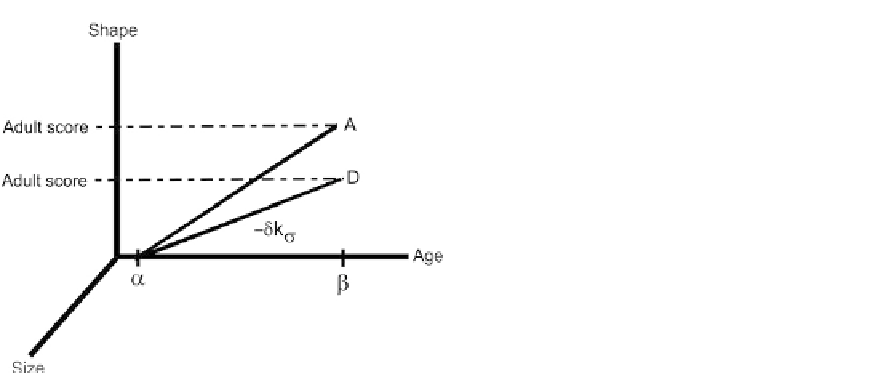Biology Reference
In-Depth Information
FIGURE 11.12
Alberch et al. (1979)
formalism for
the study of heterochrony. The clock is redrawn by
representing the ancestral shape, size and age as
three mutually orthogonal axes. Species are com-
pared with respect to the age at onset of development
(
), rate of development (k
σ
), rate of growth (k
s
), and
age at termination of development (
α
). Shown is an
example of neoteny, a decrease in developmental rate
(
β
k
σ
). The score for the descendant's adult shape is
lower than that of the ancestor's, so the descendant
adult has the morphology of a younger stage in the
ancestral ontogeny. See
Table 11.5
for the names of
the heterochronic perturbations defined by changes
in these three parameters.
2
δ
TABLE 11.5
Definitions of the Eight Pure Heterochronic Perturbations and their Morphological Expression,
as Defined by
Alberch et al. (1979)
Control Parameter
Incremental Change
Process
Morphological Expression
α
2
δα
Predisplacement
Peramorphosis
1
δα
Postdisplacement
Pedomorphosis
β
2
δβ
Progenesis
Pedomorphosis
1
δβ
Hypermorphosis
Peramorphosis
K
σ
2
δ
k
σ
Neoteny
Pedomorphosis
1
δ
k
σ
Acceleration
Peramorphosis
2
δ
ks
ks
Proportional giantism
2
δ
ks
Proportional dwarfism
(i.e. the rate of change in shape); and (4) k
s
the rate of growth (i.e. the rate of change in
size). Each parameter can differ in two directions (and increase or decrease) yielding the
eight pure heterochronic perturbations (
Table 11.5
). Each produces either a pedomorphic
(
childlike) descendant or the converse, a peramorphic descendant, i.e. one who goes
“beyond” the endpoint of the ancestral trajectory. There are also two perturbations of
growth rate yielding proportional giantism and dwarfism, which are not usually consid-
ered to be heterochronic perturbations because they do not yield either pedomorphic or
peramorphic descendants. Instead, they yield giant or miniature replicas of the ancestral
shape. Nevertheless, they are usually included for the sake of completeness.
Of course, combinations of these pure cases are also possible. Naming the combinations
is less straightforward and if we found a combination of
5
1
δ
k
s
and
2
δ
k
, for example,
σ





